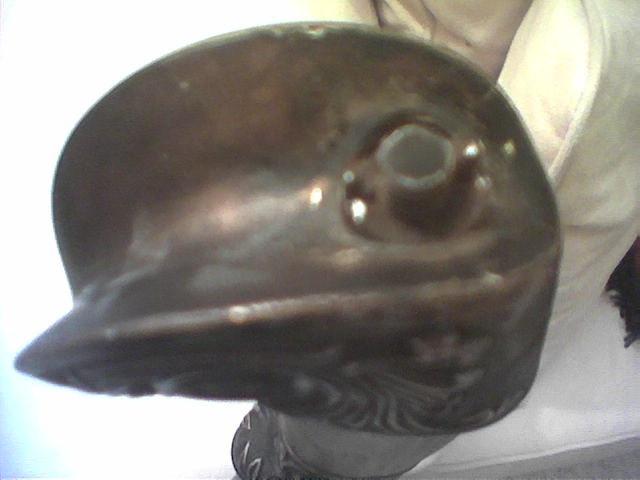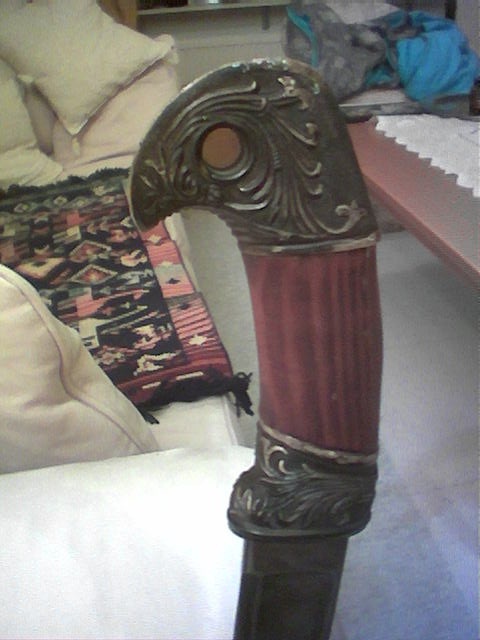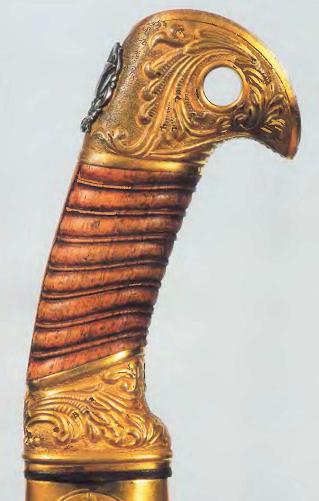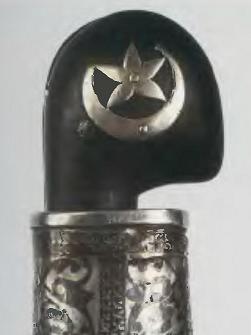| Author |
Message |
Artis Aboltins

|
 Posted: Thu 18 Mar, 2010 3:15 pm Post subject: Sword identification Posted: Thu 18 Mar, 2010 3:15 pm Post subject: Sword identification |
 |
|
A friend of mine asked if I could identify a sword he has around his house, aparently, something his grandfather have acquired at some point between 1950ies and 1970ies. Since that sort of blades usually falls outside my own period of interest, perharps someone can shed some light?
 Attachment: 31.23 KB Attachment: 31.23 KB

 Attachment: 71.23 KB Attachment: 71.23 KB

 Attachment: 174.41 KB Attachment: 174.41 KB
[ Download ]
 Attachment: 158.42 KB Attachment: 158.42 KB
[ Download ]
|
|
  |
 |
Luka Borscak

|
 Posted: Thu 18 Mar, 2010 3:32 pm Post subject: Posted: Thu 18 Mar, 2010 3:32 pm Post subject: |
 |
|
|
I think it's shaska... Russian or Ukrainian. But if it is original or not and what date, I have no idea...
|
|
  |
 |
|
Timo Nieminen
|
 Posted: Thu 18 Mar, 2010 3:34 pm Post subject: Posted: Thu 18 Mar, 2010 3:34 pm Post subject: |
 |
|
It's a shashka, a Cossack sabre, adopted by the Russians as a standard cavalry sword, continued in use in the Soviet Union.
This is in the style of the standard military version, but has ornamentation on the pommel that isn't on the standard sword. So, it's either an officer's sword (don't know if they were allowed fancy ones in the Red Army, but before then it would seem likely), a presentation sword, a civilian sword based on the military pattern, or a tourist piece or fake.
There are very many low-quality Chinese fakes to be found on ebay etc.; this is not one of them (and wouldn't be, from the age). A better replica (and sold as such) is by Weapon Edge, available from and viewable at http://www.stromloswords.com/russian_swords.html - compare the ornamentation on this with your friend's.
Kizlyar make some nice modern shashkas, of the more traditional style rather than the derived military pattern; I have their basic model and it's an agile 700g, very nice for light targets. (Google image for "kizlyar shashka" and you will see.)
|
|
   |
 |
Artis Aboltins

|
 Posted: Thu 18 Mar, 2010 3:46 pm Post subject: Posted: Thu 18 Mar, 2010 3:46 pm Post subject: |
 |
|
|
Thank you for quick response! With this information we can look deeper into the swords of this type and perharps come up with more detailed information about it's past.
|
|
  |
 |
Jean Thibodeau

|
 Posted: Thu 18 Mar, 2010 10:55 pm Post subject: Posted: Thu 18 Mar, 2010 10:55 pm Post subject: |
 |
|
Interesting sword type as well: I wonder why and to what advantage that this type has no guard to speak of ? Traditional with the Cossacks and I guess to keep it a Cossacks sword when adopted by the Russian they didn't decide to change it and add a guard. This I would guess to keep it associated to The Cossacks' reputation as fierce fighters. 
You can easily give up your freedom. You have to fight hard to get it back!
|
|
  |
 |
|
Timo Nieminen
|
 Posted: Fri 19 Mar, 2010 1:40 am Post subject: Posted: Fri 19 Mar, 2010 1:40 am Post subject: |
 |
|
| Jean Thibodeau wrote: | Interesting sword type as well: I wonder why and to what advantage that this type has no guard to speak of ? Traditional with the Cossacks and I guess to keep it a Cossacks sword when adopted by the Russian they didn't decide to change it and add a guard. This I would guess to keep it associated to The Cossacks' reputation as fierce fighters.  |
By the late 1800s, and into the 1900s, what use is a sword guard? (You could also ask as to use a sword was for cavalry by that time - Australian Light Horse didn't take swords when they went to fight in WW1 (their famous charge at Beersheba being with bayonets in hand).) May as well be traditional.
I see that Wikipedia http://en.wikipedia.org/wiki/Shashka claims that "shashka" is, etymologically, "long knife". However, there was also a dragoon shashka, which did have a guard, a simple knuckle bow. So, 3 shashkas, the Cossack shashka, like the one that started this thread, the Caucasian shashka (with the rounded pommel), and the dragoon shashka (a purely military sword AFAIK). Lots of shashka pictures at http://www.russianswords.com/swords.htm .
|
|
   |
 |
|
Lafayette C Curtis
|
 Posted: Sun 21 Mar, 2010 2:55 am Post subject: Posted: Sun 21 Mar, 2010 2:55 am Post subject: |
 |
|
| Timo Nieminen wrote: | | By the late 1800s, and into the 1900s, what use is a sword guard? (You could also ask as to use a sword was for cavalry by that time - Australian Light Horse didn't take swords when they went to fight in WW1 (their famous charge at Beersheba being with bayonets in hand).) May as well be traditional. |
The Australian Light Horse eventually realized the usefulness of swords and scrounged them up from any source they could find, however--and there were several battles during the Russian Civil War, the Polish-Soviet War, and even the German invasion of Poland where cavalry sabers still proved to be an effective weapon (in the last case when Polish cavalry made surprise attacks against infantry columns left behind by the mechanized spearheads).
|
|
  |
 |
|
Timo Nieminen
|
 Posted: Sun 21 Mar, 2010 4:15 am Post subject: Posted: Sun 21 Mar, 2010 4:15 am Post subject: |
 |
|
| Lafayette C Curtis wrote: | | Timo Nieminen wrote: | | By the late 1800s, and into the 1900s, what use is a sword guard? (You could also ask as to use a sword was for cavalry by that time - Australian Light Horse didn't take swords when they went to fight in WW1 (their famous charge at Beersheba being with bayonets in hand).) May as well be traditional. |
The Australian Light Horse eventually realized the usefulness of swords and scrounged them up from any source they could find, however |
Must be time for the Real Story! All of the above is a little misleading - the key point being that the ALH was not cavalry, but mostly mounted infantry, formed (I am led to believe) in imitation of the Boers. "Mostly", because the official doctrine gave them mounted duties, such as reconnaissance. But the intent was to only fight dismounted. It seems the official doctrine also specified the role of "pure" mounted infantry (without these mounted duties), but we never raised any such units. Anyway, they didn't even take their horses with them when they went to Gallipoli (the horses stayed in Egypt).
But in the end of the war, they were converting to become "proper" cavalry (something given much support by the success at Beersheba, and rather disappointing dismounted attacks elsewhere). Which brought swords. The post-war army was to have cavalry units.
I don't know about scrounging, or what the men thought of it (reading suggestions are most welcome!); I only know about the official end of it.
A nice account is to be had in J. Bou, Journal of Military History 71, 99 (2007) (and 3 other papers on cavalry of that era in the same issue).
| Lafayette C Curtis wrote: | | and even the German invasion of Poland where cavalry sabers still proved to be an effective weapon (in the last case when Polish cavalry made surprise attacks against infantry columns left behind by the mechanized spearheads). |
That the cases when sabres were genuinely useful are notable exception says a lot about their general usefulness. At such a point, if you're going to have the men carry them about, sabres without guards are at least easier to carry and wear. You'll only miss having guards if you get into cavalry versus cavalry, sword versus sword, and the wise cavalry units will use their MGs instead (like the Polish lancers were wise enough to use their anti-tank guns against German armour during the German attack).
Some of the late cavalry charges were with pistol or carbine in hand, rather than sword or lance, but the Savoia regiment charged with sabres in hand in August 1942, on the Eastern Front. They used captured shashkas (in addition to their own Italian swords).
|
|
   |
 |
|
Timo Nieminen
|
 Posted: Fri 09 Apr, 2010 8:44 pm Post subject: Posted: Fri 09 Apr, 2010 8:44 pm Post subject: |
 |
|
Saw two shashkas with very similar ornamentation (not quite identical, but close) in I. N. Zdobnov, Edged weapons of the Red Army 1918-1940 (Kholodnoe oruzhie Krasnoy Armii 1918-1940), KATP-13068, 2005.
These appear to be from about 1921 or 1922, but the text is in Russian, and I keep my Russian dictionary in my office, so I'm not reading it so successfully here. Pics attached.
 Attachment: 24.46 KB Attachment: 24.46 KB

Shashka hilt, c. 1922?, Zdobnov 2005, pg 129
 Attachment: 23.94 KB Attachment: 23.94 KB

Shashka hilt, c. 1922?, Zdobnov 2005, pg 135
|
|
   |
 |
|
GG Osborne
|
 Posted: Sat 10 Apr, 2010 9:50 am Post subject: Posted: Sat 10 Apr, 2010 9:50 am Post subject: |
 |
|
Another interesting point is that the scabbards for these weapons covered up nearly the entire grip. The characteristic "bird's beak" on the pommel is to facilitate getting a grip on the, well, grip, to draw the sword.
"Those who live by the sword...will usually die with a huge, unpaid credit card balance!"
|
|
  |
 |
|
Timo Nieminen
|
 Posted: Sat 10 Apr, 2010 3:03 pm Post subject: Posted: Sat 10 Apr, 2010 3:03 pm Post subject: |
 |
|
Not on the standard military "Cossack" shashka. On the "Caucasian" hilt shashka, which was also used in the army, yes.
One of the pics above shows the shashka in the scabbard. On both, you can see the leather pad. If the blade end of the handle is flat, with a leather pad, the handle doesn't go into the scabbard. A pic below of a Caucasian hilt in scabbard, and a pic (of a different sword) showing the profile of the grip.
I like the grip-in-scabbard method, since you get a good tight fit, well-sealed and secure, and once you've pulled it out a tiny fraction, very easy to draw. Common for knives (especially in the past, maybe less so now, but still used), less so for swords (unless you call a Khyber knife a sword). The blade end of the grip functions in the same way as the habaki on a Japanese sword.
 Attachment: 10.03 KB Attachment: 10.03 KB

Zdobnov 2005, cited up-thread, pg 31
 Attachment: 3.72 KB Attachment: 3.72 KB

Zdobnov 2005, cited up-thread, pg 37
|
|
   |
 |
|
Lafayette C Curtis
|
 Posted: Sun 11 Apr, 2010 1:00 am Post subject: Posted: Sun 11 Apr, 2010 1:00 am Post subject: |
 |
|
| Timo Nieminen wrote: | | Lafayette C Curtis wrote: | | Timo Nieminen wrote: | | By the late 1800s, and into the 1900s, what use is a sword guard? (You could also ask as to use a sword was for cavalry by that time - Australian Light Horse didn't take swords when they went to fight in WW1 (their famous charge at Beersheba being with bayonets in hand).) May as well be traditional. |
The Australian Light Horse eventually realized the usefulness of swords and scrounged them up from any source they could find, however |
Must be time for the Real Story! All of the above is a little misleading - the key point being that the ALH was not cavalry, but mostly mounted infantry...
(snip for brevity)
A nice account is to be had in J. Bou, Journal of Military History 71, 99 (2007) (and 3 other papers on cavalry of that era in the same issue). |
Interesting. I'll try to go and look for that JMH article. On the other hand, I've been reading Donald Kenyon's thesis on the employment of cavalry on the Western Front in World War I, and it appears that they could actually be quite effective even in their traditional shock role; once past the impractical terrain of the trenches, a loose line of horsemen charging across the open could often sweep up considerable numbers of infantry and even isolated machinegun positions with surprising efficiency. It's really an eye-opener because I've previously been wondering why WW1 seemed to be a big black spot in the history of cavalry, with effective cavalry actions before and after but not during the war--and it turns out that it wasn't an exception at all, only that the cavalry didn't have much opportunity to act in its ideal role of exploiting breakthroughs and operating in the enemy's rear.
| Quote: | That the cases when sabres were genuinely useful are notable exception says a lot about their general usefulness. At such a point, if you're going to have the men carry them about, sabres without guards are at least easier to carry and wear. You'll only miss having guards if you get into cavalry versus cavalry, sword versus sword, and the wise cavalry units will use their MGs instead (like the Polish lancers were wise enough to use their anti-tank guns against German armour during the German attack).
Some of the late cavalry charges were with pistol or carbine in hand, rather than sword or lance, but the Savoia regiment charged with sabres in hand in August 1942, on the Eastern Front. They used captured shashkas (in addition to their own Italian swords). |
Quite true. But note that I'm not arguing for against the use of knuckle-guards on swords--only that the cavalry sword continued to be an effective weapon for much longer than people believed. And there were still a fair number of cavalry-on-cavalry actions where charges with sabers drawn still proved decisive, especially on less heavily-mechanized battlefields of Eastern Europe (such as in the Polish-Soviet War and the Russian Civil War, as I've mentioned before). It's also worth noting that the Far East hosted a number of little-known large-scale traditional cavalry operations both during the SIno-Japanese War and the Chinese Civil War (plus some even less well-known skirmishes between Japanese/Manchukuo and Soviet/Soviet-sponsored forces), and some of these actions apparently involved cavalry vs. cavalry combats with drawn swords. In all these cases, while actual swordfights were rare, the presence of the sword itself gave sword-armed cavalry the imperative to advance, which was quite important in forcing their enemies to flee or surrender. (In the words of a White Russian officer commenting on RCW cavalry battles, "Shock does not exist but it is imperative to seek shock in order to gain victory.")
Therein lies my contention against your statement of "You could also ask as to use a sword was for cavalry by that time." It might no longer be the cavalry's primary or preferred weapon but it still proved quite handy in a large number of cases, and wise cavalry commanders still allowed/required their units to keep swords for those times when the suddenness and momentum of cavalry shock action could still prove decisive in the absence of a better mobile assault arm (i.e. armored or mechanized units).
|
|
  |
 |
|
Timo Nieminen
|
 Posted: Sun 11 Apr, 2010 5:20 pm Post subject: Posted: Sun 11 Apr, 2010 5:20 pm Post subject: |
 |
|
| Lafayette C Curtis wrote: |
Quite true. But note that I'm not arguing for against the use of knuckle-guards on swords--only that the cavalry sword continued to be an effective weapon for much longer than people believed.
...
Therein lies my contention against your statement of "You could also ask as to use a sword was for cavalry by that time." It might no longer be the cavalry's primary or preferred weapon but it still proved quite handy in a large number of cases, and wise cavalry commanders still allowed/required their units to keep swords for those times when the suddenness and momentum of cavalry shock action could still prove decisive in the absence of a better mobile assault arm (i.e. armored or mechanized units). |
I don't doubt that swords could be useful, and effective weapons. It isn't that much of a deal for cavalry to carry a sword, and the cost of a sword is a small thing compared to the cost of the horse, the training, the upkeep, etc. It was very seriously asked whether or not cavalry should bother carrying them, and this is a different matter, a question of how often they will be useful and efective weapons, and if the soldiers would be better off carrying something else, and training with something else. Training time devoted to the sword might be a serious issue. To have sword in hand instead of carbine in hand or pistol in hand could lead to less effectiveness. It wasn't a stupid question to ask, at the time.
Experience in the Boer War(s) encouraged "no" as the answer, WWI experience said otherwise. Thus the evolution of the Australian Light Horse.
I think that the "no"-sayers were also rejecting swords as part of a deliberate reform program to change the role of cavalry. Take away an essential tool of the old undesired role, and they won't waste time playing with the old ways. Don't give the 21st Lancers such tools, and they won't lose 25% at Omdurman. No swords might mean less versatility, and higher losses on occasion. With that outweight the potential losses from idiots charging inappropriately?
The real solution is, of course, to not have idiots in charge. maybe they thought it's easier to get rid of the swords than to get rid of idiots?
Australian Light Horse losses when attacking dismounted were pretty convincing evidence that "modern" tactics didn't automatically mean lower losses. The Western Front in WWI doesn't say very much at all about the utility of cavalry - who expects cavalry to be useful in an artillery-rich extended siege operation?
(Exactly the same issue exists with bayonets.)
|
|
   |
 |
Etienne Hamel

Location: Granby (QC) canada Joined: 09 Sep 2006
Posts: 443
|
 Posted: Sun 11 Apr, 2010 7:11 pm Post subject: Posted: Sun 11 Apr, 2010 7:11 pm Post subject: |
 |
|
|
i know it is off topic but am i the only one who think the russian shaska style would make a nice fantasy project with a scimitar blade? of course if you add a guard with similar style of relief on it
|
|
  |
 |
|
Christopher Treichel
Location: Metro D.C. Joined: 14 Jan 2010
Posts: 268
|
 Posted: Mon 12 Apr, 2010 8:02 am Post subject: Posted: Mon 12 Apr, 2010 8:02 am Post subject: |
 |
|
I was always told that the Shashka did not have a guard as it was utilized by combining the speed of the horse with a backhand cut to drag the sword through the target instead of trying to stab the target.
I own a peculiar shashka completely devoid of any real marks. has a small circle with some figure in it on the blade as well as a cyrillic "D."
|
|
  |
 |
Gottfried P. Doerler

|
 Posted: Mon 12 Apr, 2010 11:45 am Post subject: Posted: Mon 12 Apr, 2010 11:45 am Post subject: |
 |
|
Also, i think, a change to a regime like the bolsheviks, encourages to drop old (czarist) tradition, instead of conserving.
so there surely must have been some use in cavalry sword this time.
i`ve picture of a ww1 sashka with attached mosin-nagant bayonett on the scabbard, i regret i`ve forgotten where i found it.
 Attachment: 23.84 KB Attachment: 23.84 KB

|
|
  |
 |
|
|
You cannot post new topics in this forum
You cannot reply to topics in this forum
You cannot edit your posts in this forum
You cannot delete your posts in this forum
You cannot vote in polls in this forum
You cannot attach files in this forum
You can download files in this forum
|
All contents © Copyright 2003-2025 myArmoury.com — All rights reserved
Discussion forums powered by phpBB © The phpBB Group
Switch to the Basic Low-bandwidth Version of the forum
|

